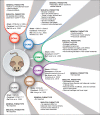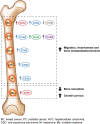CCN proteins in the musculoskeletal system: current understanding and challenges in physiology and pathology
- PMID: 34228239
- PMCID: PMC8642527
- DOI: 10.1007/s12079-021-00631-5
CCN proteins in the musculoskeletal system: current understanding and challenges in physiology and pathology
Abstract
The acronym for the CCN family was recently revised to represent "cellular communication network". These six, small, cysteine-enriched and evolutionarily conserved proteins are secreted matricellular proteins, that convey and modulate intercellular communication by interacting with structural proteins, signalling factors and cell surface receptors. Their role in the development and physiology of musculoskeletal system, constituted by connective tissues where cells are interspersed in the cellular matrix, has been broadly studied. Previous research has highlighted a crucial balance of CCN proteins in mesenchymal stem cell commitment and a pivotal role for CCN1, CCN2 and their alter ego CCN3 in chondrogenesis and osteogenesis; CCN4 plays a minor role and the role of CCN5 and CCN6 is still unclear. CCN proteins also participate in osteoclastogenesis and myogenesis. In adult life, CCN proteins serve as mechanosensory proteins in the musculoskeletal system providing a steady response to environmental stimuli and participating in fracture healing. Substantial evidence also supports the involvement of CCN proteins in inflammatory pathologies, such as osteoarthritis and rheumatoid arthritis, as well as in cancers affecting the musculoskeletal system and bone metastasis. These matricellular proteins indeed show involvement in inflammation and cancer, thus representing intriguing therapeutic targets. This review discusses the current understanding of CCN proteins in the musculoskeletal system as well as the controversies and challenges associated with their multiple and complex roles, and it aims to link the dispersed knowledge in an effort to stimulate and guide readers to an area that the writers consider to have significant impact and relevant potentialities.
Keywords: Bone metastasis; Bone sarcomas; Cellular communication network; Osteoarthritis; Rheumatoid arthritis; Skeletogenesis.
© 2021. The Author(s).
Conflict of interest statement
The authors declare that there is no conflict of interest.
Figures






Similar articles
-
Targeting CCN Proteins in Rheumatoid Arthritis and Osteoarthritis.Int J Mol Sci. 2021 Apr 21;22(9):4340. doi: 10.3390/ijms22094340. Int J Mol Sci. 2021. PMID: 33919365 Free PMC article. Review.
-
The CCN proteins: important signaling mediators in stem cell differentiation and tumorigenesis.Histol Histopathol. 2010 Jun;25(6):795-806. doi: 10.14670/HH-25.795. Histol Histopathol. 2010. PMID: 20376786 Free PMC article. Review.
-
Temperal and spatial expression of CCN1, CCN3, CCN4, CCN5 and CCN6 proteins in the developing postnatal teeth.J Cell Commun Signal. 2023 Jun;17(2):275-285. doi: 10.1007/s12079-023-00758-7. Epub 2023 May 9. J Cell Commun Signal. 2023. PMID: 37160590 Free PMC article.
-
The regulation and functions of the matricellular CCN proteins induced by shear stress.J Cell Commun Signal. 2023 Jun;17(2):361-370. doi: 10.1007/s12079-023-00760-z. Epub 2023 May 16. J Cell Commun Signal. 2023. PMID: 37191841 Free PMC article. Review.
-
Role of CCN, a vertebrate specific gene family, in development.Dev Growth Differ. 2009 Jan;51(1):55-67. doi: 10.1111/j.1440-169X.2009.01077.x. Dev Growth Differ. 2009. PMID: 19128405 Review.
Cited by
-
A monoallelic variant in CCN2 causes an autosomal dominant spondyloepimetaphyseal dysplasia with low bone mass.Bone Res. 2024 Oct 16;12(1):60. doi: 10.1038/s41413-024-00364-2. Bone Res. 2024. PMID: 39414788 Free PMC article.
-
Clinical significance of CTGF and Cry61 protein in extraocular muscles of strabismic patients.Graefes Arch Clin Exp Ophthalmol. 2023 Oct;261(10):2845-2851. doi: 10.1007/s00417-023-06096-z. Epub 2023 May 10. Graefes Arch Clin Exp Ophthalmol. 2023. PMID: 37162563
-
Biallelic variants in CCN2 underlie an autosomal recessive kyphomelic dysplasia.Eur J Hum Genet. 2025 Jan;33(1):30-37. doi: 10.1038/s41431-024-01725-5. Epub 2024 Nov 6. Eur J Hum Genet. 2025. PMID: 39506047 Free PMC article.
-
The role of CCNs in controlling cellular communication in the tumor microenvironment.J Cell Commun Signal. 2023 Mar;17(1):35-45. doi: 10.1007/s12079-022-00682-2. Epub 2022 Jun 8. J Cell Commun Signal. 2023. PMID: 35674933 Free PMC article. Review.
-
Matricellular proteins in immunometabolism and tissue homeostasis.BMB Rep. 2024 Sep;57(9):400-416. doi: 10.5483/BMBRep.2023-0156. BMB Rep. 2024. PMID: 38919018 Free PMC article. Review.
References
Publication types
Grants and funding
LinkOut - more resources
Full Text Sources
Miscellaneous

